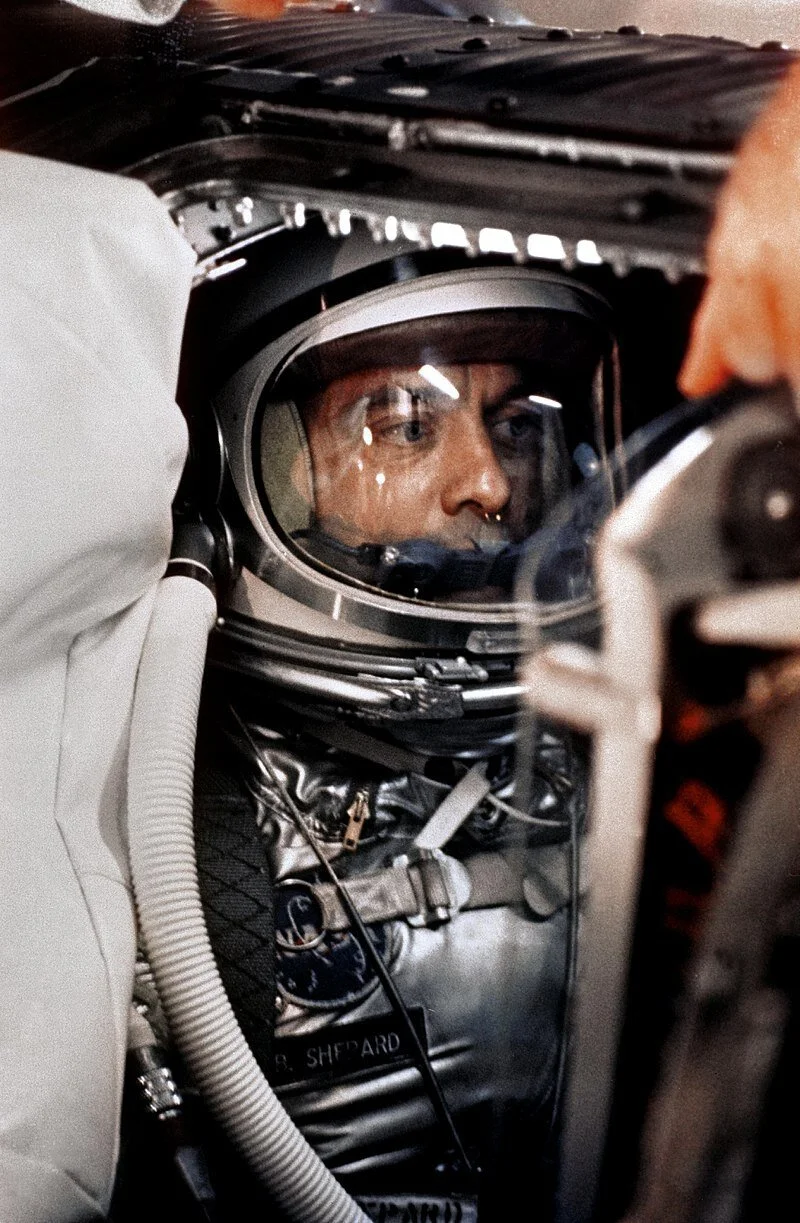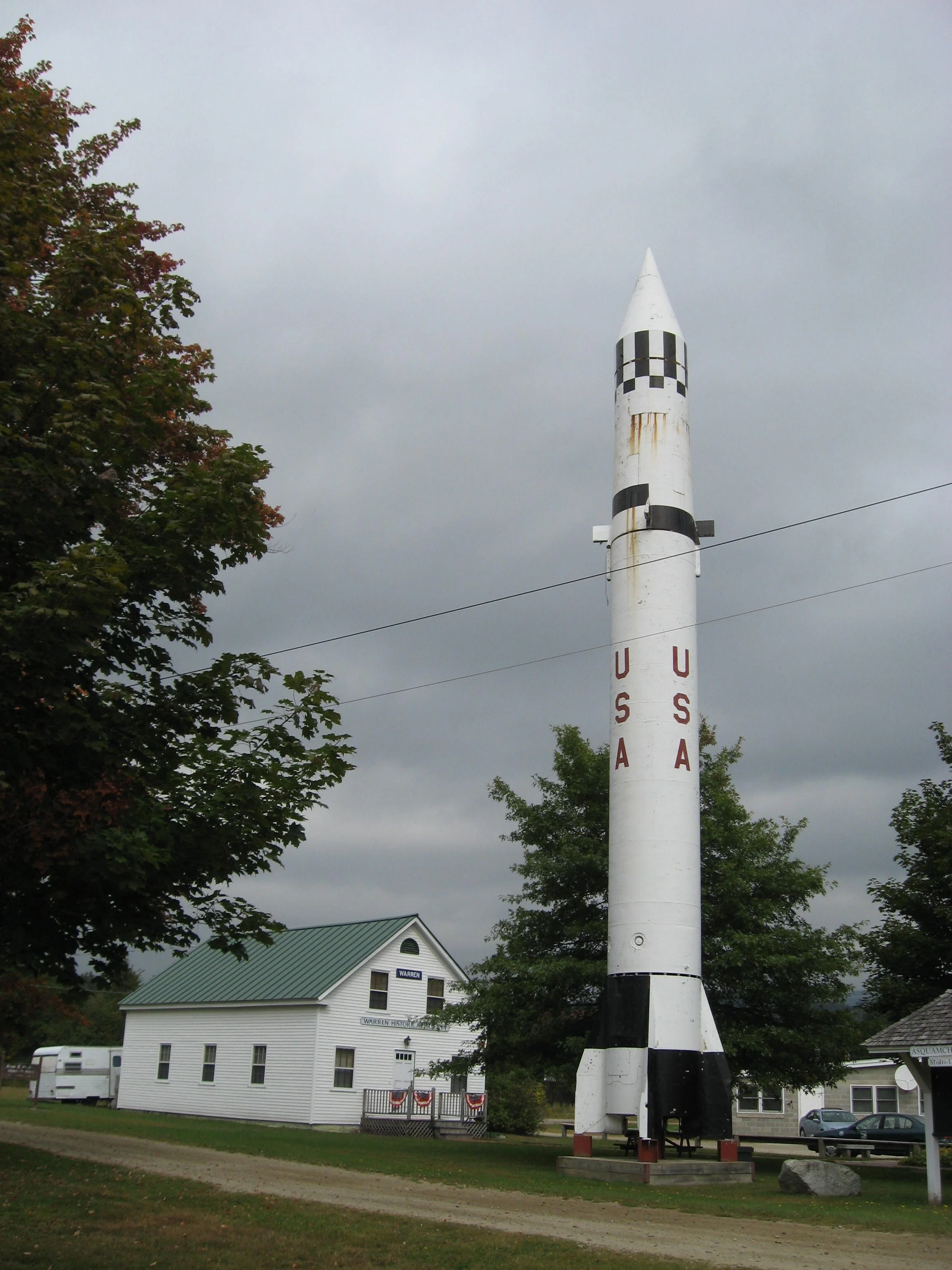Virtual Exhibit: Mercury Redstone Rocket
In November 2008, the McAuliffe-Shepard Discovery Center erected a life sized Redstone Rocket in front of the new Discovery Center building changing the landscape of the campus forever. Check out the article below to learn a little bit more about the Redstone Rocket, its significance in the history of space travel and how this replica made its way to Concord, NH!
Alan shepard in the Freedom 7 capsule before launch on May 5, 1961. Photo credit nasa
In the late 1950s, NH Native Alan Shepard, was selected along with 507 other graduates of test pilot schools in a rigorous selection process that ultimately was narrowed down to 7 candidates, dubbed the Mercury Seven astronauts. On January 19, 1961, Robert R. Gilruth, the director of NASA's Space Task Group, informed the seven astronauts that Shepard had been chosen for the first American crewed mission into space. It was not until May 5, 1961, after the launch date had been rescheduled a hand full of times, that Shepard became the second man in space and first American. He followed Soviet Yuri Gargarin, who became the first person in space and to orbit the Earth early that April.
diagram of shepard’s freedom 7 capsule.
Shepard conducted his space flight tightly positioned in a Mercury 7 capsule atop at Redstone rocket. The capsule was outfitted with all the necessities for life that Shepard needed during his 15-minute space flight. It included a life support system and electrical power. The capsule also included a radio to communicate and transmit data and gave Shepard the ability to manually maneuver in space by using thrusters with pressurized hydrogen-peroxide fuel-controlled pitch, roll and yaw. A heat shield was made of fiber glass bonded with phenolic resin, which when re-entering the atmosphere, friction and compression heated and slowly vaporized the shield, carrying the heat away. Once Shepard had re-entered Earth’s atmosphere, a drogue parachute was deployed at 21,000 feet and the main parachute was deployed at 10,000 feet to slow the capsule down. Just before the capsule hit the water, a landing bag was inflated to keep the capsule upright in the water until Shepard was able to be extracted from the capsule. This highly engineered capsule was then strapped to the top of a Redstone Rocket, primarily built and used for missiles!
The Redstone rocket was originally developed in Huntsville, Alabama as a ballistic missile to deliver one or more warheads to a predetermined destination. First launched in 1953, the PGM-11 Redstone was a short-range missile, and from 1958 to 1964, they were used in live nuclear missile tests. From original Redstone models, other models were derived, including Juno 1 that launched Explorer 1 (the first U.S. orbital satellite into space), and the Mercury-Redstone, which carried the first two American astronauts into space, Alan Shepard and Gus Grissom.
redstone missile in warren, nh town common. it was erected next to the town’s historical society.
The first Redstone rocket that made its way to New Hampshire remains to this day in Warren, NH. The Redstone missile came to Warren on April 21, 1971. Henry “Ted” Asselin, with permission of the U.S. Defense Support Agency, and the selectmen from Huntsville, Alabama, brought the rocket to Warren on a 77-foot truck and trailer. Ted was stationed with the army at Redstone Arsenal in Alabama and had noticed several Redstone rockets lying in a field, now considered surplus. The eight-ton missile he brought back to NH was stripped of its engine and guidance control package and secured in an eight-foot-deep foundation with five huge steel l-beams set in cement. A crane transferred the missile onto the upright beams where it remains today. The Redstone rocket is capped off at the top because it is missing the capsule that would have been on the top of the rocket before take off. The capsules, that are retrieved after each successful space flight, remain on display in museums across the United States.
Alan Shepard's Freedom 7 Mercury spacecraft as it is displayed at the Naval Academy in Annapolis, Maryland, 2012. Image credit © heroicrelics.com/Mike Jetzer
A Mercury 7 Redstone Replica
The McAuliffe-Shepard Discovery Center, originally the Christa McAuliffe Planetarium, was constructed in 1990 to honor Concord native, Christa McAuliffe. By the early 2000’s the Planetarium has been such a success it was proposed that it expand to include a science center. The science center was named in honor of Alan Shepard. Together the planetarium and the science center were rebranded the McAuliffe-Shepard Discovery Center. The new expansion was finished in 2009. The Discovery Center has welcomed tens of thousands of visitors each year since.
replica redstone rocket at night. notice the moon on the right side of the rocket and venus on the left.
The decision to have a Mercury Redstone rocket replica made was proposed with the expansion of the building. The Discovery Center was not only expanding in size but desired a revitalized identity. The replica was commissioned using allocated NASA funds and is an exact 1:1 replica of the Mercury Redstone rocket that took Alan Shepard to space. The replica was designed by Edquist-Davis exhibits (Seattle, WA) and built by H.B. Stubbs (Warren, Michigan). The plaza holding the rocket was designed by Architect Roger Dignard/Dignard Architectural Services (New Boston, NH) and the exhibits surrounding the rocket were designed by Edquist-Davis exhibits, built by H.B. Stubbs, and repaired when needed by devoted volunteer J. Paul Higgins of Bedford, NH!
replica mercury redstone rocket is delivered to the discovery center in november 2008.
The rocket arrived in New Hampshire on November 18, 2008 and was erected with a large crowd watching and WMUR filming. The science center was not yet complete, (the museum was opened on March 6, 2009), but the rocket was in place and ready for the opening. Since it is a replica, it was not outfitted with an engine. It is firmly lodged in place by 10 steel rods that go deep into the ground, an innovative approach suggested by Ty Sundstrom (Exeter CA), a colleague of David Edquist's, so the rocket requires no guy lines, and is designed to handle gale force winds and remain standing. It won’t be going anywhere!
The Discovery center’s replica redstone rocket on a beautiful summer day. the rocket can be seen driving on Route 93.
Unlike the rocket in Warren that lacks a capsule, the replica rocket at the Discovery Center is topped by a capsule and a 19’ 2” emergency escape tower. An escape tower was designed to lift the capsule off the booster, high enough to deploy a parachute and far enough away from the launch pad to bring the capsule and astronaut safely to the ground.
Today, visitors identify the Discovery Center by its iconic exterior structure, a 92-foot tall replica of the Mercury-Redstone Rocket. During this time of uncertainty and closures, the Redstone Rocket stands tall outside the Discovery Centers walls serving as a reminder to all that drive by it, or take their daily walk by it, that we are here to stay!
The replica redstone rocket at the discovery center at sunset. notice the Mercury 7 capsule replica at the top and emergency escape tower.








